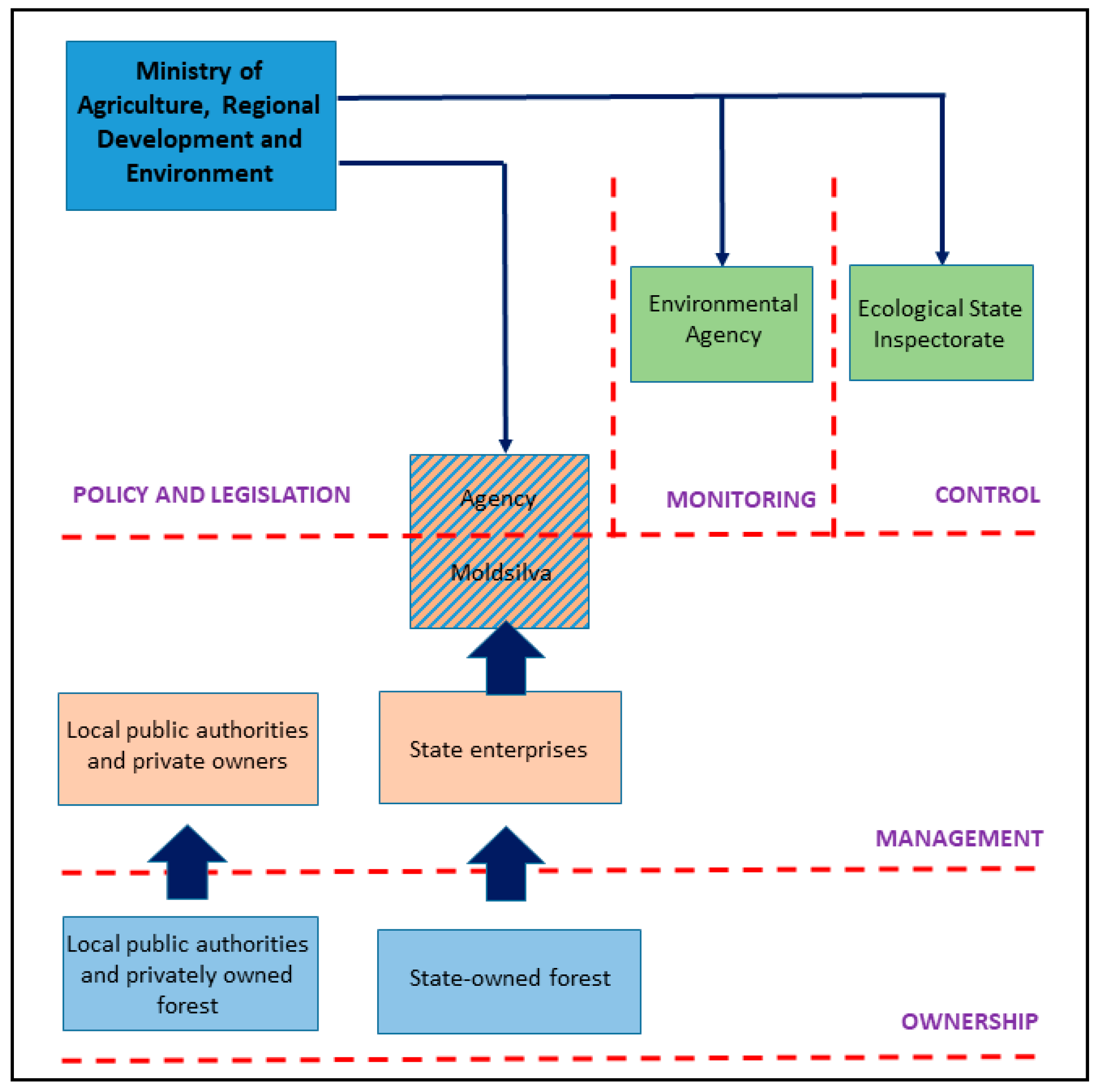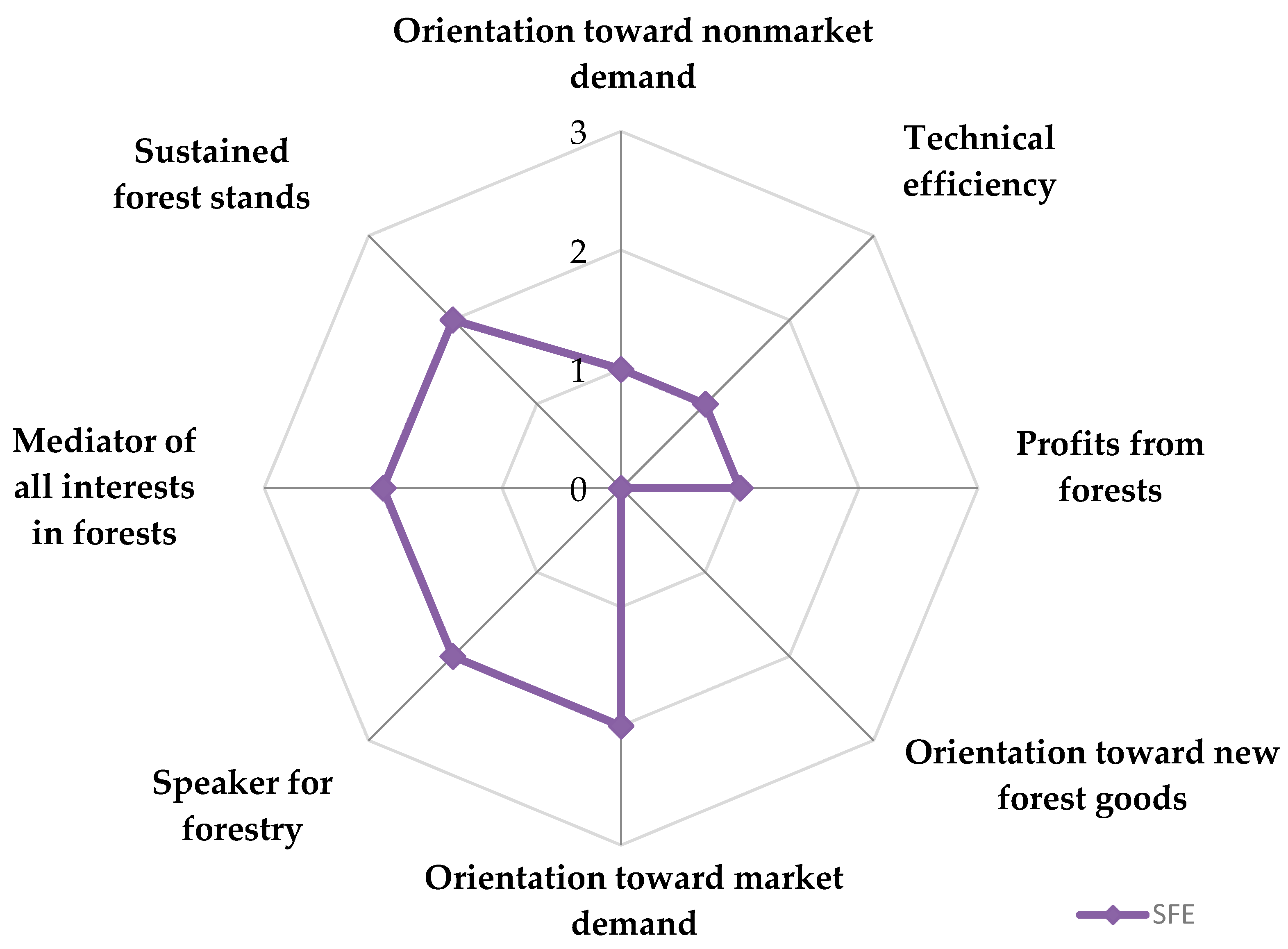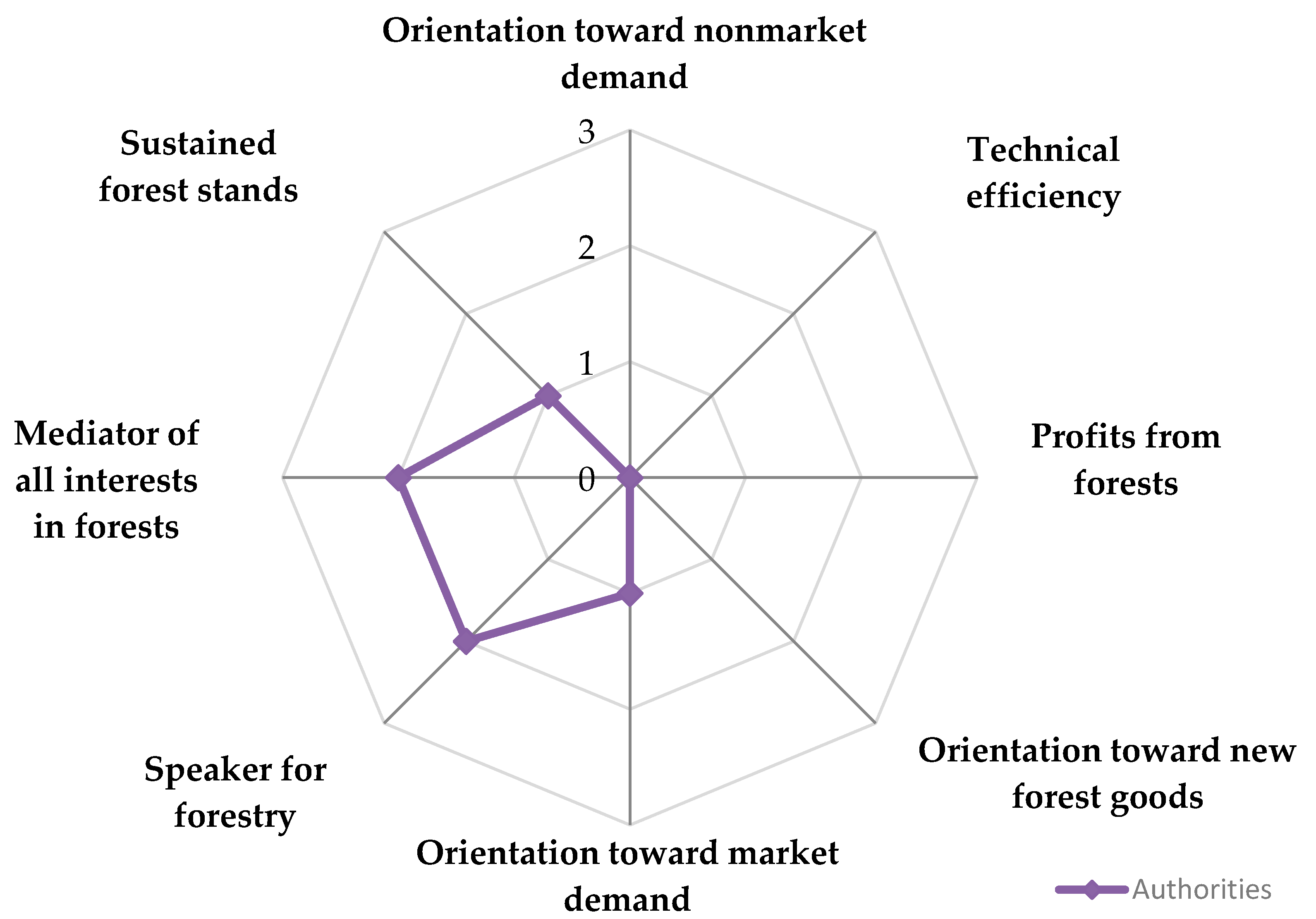Analysis of State Forest Institutions in the Republic of Moldova, Using a Causative Model
Abstract
1. Introduction
2. Moldova Forest Sector Snapshot
3. Materials and Methods
3.1. The 3L Benchmarking Model as a Theoretical Basis for Institutional Analysis
3.2. Empirical Evidence Collection and Analysis
4. Results
4.1. Forest Policy Goals
4.2. Institutions with Management Tasks—State Forest Enterprises
4.2.1. C1: Orientation toward Market Demand
4.2.2. C2: Orientation toward Nonmarket Demand
4.2.3. C3: Sustained Forest Stands
4.2.4. C4: Technical Efficiency
4.2.5. C5: Profits from Forests
4.2.6. C6: Orientation toward New Forest Goods
4.2.7. C7: Speaker for Forestry
4.2.8. C8: Mediator of All Interests in Forests
4.3. Institutions with Authority Tasks
4.3.1. C1: Orientation toward Market Demand
4.3.2. C2: Orientation toward Nonmarket Demand
4.3.3. C3: Sustained Forest Stands
4.3.4. C4: Technical Efficiency
4.3.5. C5: Profits from Forests
4.3.6. C6: Orientation toward New Forest Goods
4.3.7. C7: Speaker for Forestry
4.3.8. C8: Mediator of All Interests in Forests
5. Discussion
6. Conclusions
- SFEs are more concerned about gaining short-term wood-sourced revenues (C1) to sustain their recurrent expenditures than fulfilling the sustainability goals. However, they do not excel in this direction, as the monopolistic position discourages sectoral competition and creates incentives for not seeking alternative solutions (e.g., innovative products/services) (C6).
- Nonmarket demand is perceived by SFIs only from a forest-protective-function perspective (C2). The forest management tasks are set by the forest authorities, without consulting society or the non-state forest owners. The restrictions imposed on all forest owners are not sufficiently supported through budget allocations for state forests or compensation for non-state forests. This forces SFEs to prioritize production before protection and the non-state owners to disregard their forests as an economic/social asset.
- The policy and regulatory framework favors, in generalist and vague terms, ecologically sustainable forest management (C3), but the performance in achieving this goal is rather moderate due to self-financing, inefficient forest management structures. Although seen as the pillar of sustainable forest management in Moldova, FMPs are not properly enforced in all situations due to the need of SFEs for higher revenues. Wood consumption is higher than the official supply, indicating the incapacity of SFEs to satisfy the demand and possible illegal logging incidence.
- The needs for covering the recurrent expenditures and for investing in forest protection functions should stimulate more forest management efficiency, but our study indicates the contrary. SFEs are little technically productive (C4) and little profitable (C5) entities, as well as less innovative for new products and services (C6); however, forest authorities do not seem too concerned about it. Institutional reform that would allow a higher efficiency of SFEs, as well as a more enabling environment for innovative product and service provision, is highly recommended.
- Among all the analyzed SFIs, Moldsilva aspires the most to the role of speaker for forestry and is, in general, accepted as playing such (C7). A mediator role for all interests in forests (C8) is played by it along with SFEs that are quite active at the regional level. However, there are stakeholders that are almost not represented by Moldsilva, though forests are strategic natural resources and deserve more stakeholder engagement than now.
Supplementary Materials
Author Contributions
Funding
Acknowledgments
Conflicts of Interest
References
- Lazdinis, M.; Carver, A.; Lazdinis, I.; Paulikas, V. From union to union: Forest governance in a post-soviet political system. Environ. Sci. Policy 2009, 12, 309–320. [Google Scholar] [CrossRef]
- Abrudan, I.V. A decade of Non-State Administration of Forests in Romania: Achievements and Challenges. Int. For. Rev. 2012, 14, 275–284. [Google Scholar] [CrossRef]
- Popa, B.; Niță, M.D.; Hălălișan, A.F. Intentions to engage in forest law enforcement in Romania: An application of the theory of planned behavior. For. Policy Econ. 2019, 100, 33–43. [Google Scholar] [CrossRef]
- Brukas, V. New World, Old Ideas—A Narrative of the Lithuanian Forestry Transition. J. Environ. Policy Plan. 2014, 17, 495–515. [Google Scholar] [CrossRef]
- Teder, M.; Mizaraite, D.; Mizaras, S.; Nonic, D.; Nedeljković, J.; Savrašova, Z.; Vilkriste, L.; Zalite, Z.; Weiss, G. Structural Changes of State Forest Management Organisations in Estonia, Latvia, Lithuania, Serbia and Slovakia since 1990. Balt. For. 2015, 21, 326–339. [Google Scholar]
- Bouriaud, L.; Nichiforel, L.; Weiss, G.; Bajraktari, A.; Curovic, M.; Dobsinska, Z.; Glavonjic, P.; Jarsky, V.; Zarvasova, Z.; Teder, M.; et al. Governance of private forests in Eastern and Central Europe: An analysis of forest harvesting and management rights. Ann. For. Res. 2013, 56, 199–215. [Google Scholar] [CrossRef]
- Weiss, G.; Lawrence, A.; Hujala, T.; Lidestav, G.; Nichiforel, L.; Nybakk, E.; Quiroga, S.; Sarvašová, Z.; Suarez, C.; Živojinović, I. Forest ownership changes in Europe: State of knowledge and conceptual foundations. For. Policy Econ. 2019, 99, 9–20. [Google Scholar] [CrossRef]
- Drăgoi, M.; Popa, B.; Blujdea, V. Improving communication among stakeholders through ex-post transactional analysis—Case study of Romanian forestry. For. Policy Econ. 2011, 13, 16–23. [Google Scholar] [CrossRef]
- Ulybina, O. Russian Forest: The path of reform. For. Policy Econ. 2014, 38, 143–150. [Google Scholar] [CrossRef]
- Scriban, R.E.; Nichiforel, L.; Bouriaud, L.G.; Barnoaiea, I.; Cosofret, V.C.; Barbu, C.O. Governance of the forest restitution process in Romania: An application of DPSIR model. For. Policy Econ. 2019, 99, 59–67. [Google Scholar] [CrossRef]
- Živojinović, I.; Nedeljkovic, J.; Stojanovski, V.; Japelj, A.; Nonic, D.; Weiss, G.; Ludvig, A. Non-timber forest products in transition economies? Innovation cases in selected SEE countries. For. Policy Econ. 2017, 81, 18–29. [Google Scholar] [CrossRef]
- Lazdinis, I.; Lazdinis, M.; Carver, A.; Schmithusen, F.; Vilkriste, L. Elite Concerns in Forest Sectors of Estonia, Latvia and Lithuania. Balt. For. 2005, 11, 97–104. [Google Scholar]
- Nichiforel, L.; Keary, K.; Deuffic, P.; Weiss, G.; Thorsen, B.J.; Winkel, G.; Avdibegovic, M.; Dobsinska, Z.; Feliciano, D.; Gatto, P.; et al. How private are Europe’s private forests? A comparative property rights analysis. Land Use Policy 2018, 76, 535–552. [Google Scholar] [CrossRef]
- Chudy, R.; Stevanov, M.; Krott, M. Strategic options for state forest institutions in Poland: Evaluation by the 3L Model and ways ahead. Int. For. Rev. 2016, 18, 387–411. [Google Scholar] [CrossRef]
- Stevanov, M.; Krott, M.; Curman, M.; Krajter Ostoić, S.; Stojanovski, V. The (new) role of public forest administration in Western Balkans: Examples from Serbia, Croatia, FYR Macedonia, and Republika Srpska. Can. J. For. Res. 2018, 48, 898–912. [Google Scholar] [CrossRef]
- Hasnaoui, A.; Krott, M. Optimizing State Forest Institutions for Forest People: A Case Study on Social Sustainability from Tunisia. Sustainability 2019, 11, 1954. [Google Scholar] [CrossRef]
- Krott, M.; Stevanov, M. Comprehensive comparison of state forest institutions by a causative benchmarking model. Allgemaine Forst-und Jagdzteitung 2008, 179, 57–64. [Google Scholar]
- Mitchell, A.; Capcelea, A.; Rinnerberger, N.; Phillips, H.; Popa, B.; Lozan, A. Republic of Moldova: Forest Policy Note; Știintța: Chișinău, Republic of Moldova, 2015; 68p, ISBN 978-9975-67-973-2. [Google Scholar]
- Agenția Moldsilva. Strategia Reformei Instituționale a Sectorului Forestier din Republica Moldova. Agenția Moldsilva, Chișinău, Republica Moldova. 2012. Available online: http://particip.gov.md/proiectview.php?l=ro&idd=386 (accessed on 15 September 2020).
- Galupa, D.; Munteanu, N.; Rotaru, P.; Plăcintă, M.; Cerescu, A.; Mardari, A. Aspecte economice ale gospodăririi fondului forestier proprietatea statului în Republica Moldova. Revista Pădurilor 2018, 2, 23–36. [Google Scholar]
- Agency for Land Relations and Cadastre of the Republic of Moldova. State land Cadastre (1990–2020). 2020. Available online: http://arfc.gov.md (accessed on 16 September 2020).
- Parliament of the Republic of Moldova. Forest Code of the Republic of Moldova, no. 887-XIII from 21.06.1996. Official Gazette of the Republic of Moldova No. 4-5/36 from 16.01.1997. Available online: http://lex.justice.md/index.php?action=view&view=doc&lang=1&id=311740 (accessed on 16 September 2020).
- Parliament of the Republic of Moldova. Parliament Decision on approving the National Strategy and the Action Plan on Biodiversity Conservation, no. 350 from 12.07.2001, Official Gazette of the Republic of Moldova No. 133 from 08.11.2001. Available online: http://lex.justice.md/index.php?action=view&view=doc&lang=1&id=308876 (accessed on 17 September 2020).
- Lozan, A.; Rotaru, A. Republic of Moldova: Comparative Analysis of the National Forest Legislation with the International Legal Framework for Ensuring an Efficient Management of Forest Resources; Technical Report; ENPI FLEG II: Chișinău, Republic of Moldova, 2015; 30p, Available online: http://www.enpi-fleg.org/site/assets/files/1875/fleg_moldova_legal_analysis_report_en.pdf (accessed on 18 September 2020).
- Talpă, N.; Tiță, G.C.; Popa, B. Aplicarea conceptului serviciilor ecosistemice în sectorul forestier al Republicii Moldova. Revista Pădurilor 2019, 143, 001–056. [Google Scholar]
- Agenția Moldsilva. Raport Privind Starea Fondului Forestier și Rezultatele Activității Agenției Moldsilva în Perioada Anilor 2010–2015, Chișinău Republica Moldova. 2016. Available online: https://www.dropbox.com/s/fvhnksirvgmynrp/Raport%20stare%20resurse%20forest_2010-2015_modif.pdf?dl=0 (accessed on 10 September 2020).
- Transilvania University of Brașov. Evaluation of Forest Ecosystem Services (FES) in the Republic of Moldova. Technical Report for FLEGT. 2015. Available online: http://www.enpi-fleg.org/site/assets/files/1872/fes_moldova_2015_en.pdf (accessed on 12 September 2020).
- Guvernul Republicii Moldova. Hotărârea Guvernului Republicii Moldova nr. 695 din 30.08.2017 cu privire la organizarea și funcționarea Ministerului Agriculturii, Dezvoltării Regionale și Mediului. Monitorul Oficial al Republicii Moldova nr. 322-328, art nr. 797, din 01.09.2017, cu modificările și completările ulterioare. Available online: http://lex.justice.md/md/371190/ (accessed on 5 September 2020).
- Guvernul Republicii Moldova. Hotărârea Guvernului Republicii Moldova nr. 150 din 02.03.2010 pentru aprobarea Regulamentului privind organizarea și funcționarea Agenției Moldsilva, structurii și efectivului-limită ale aparatului central al acesteia. Monitorul Oficial al Republicii Moldova nr. 33, art nr. 204, din 05.03.2010, cu modificările și completările ulterioare. Available online: http://lex.justice.md/md/333903/ (accessed on 5 September 2020).
- Guvernul Republicii Moldova. Hotărârea Guvernului Republicii Moldova nr. 549 din 13.06.2018 cu privire la constituirea, organizarea și funcționarea Agenției de Mediu. Monitorul Oficial al Republicii Moldova nr. 210-223, art nr. 603, din 22.06.2018. Available online: http://lex.justice.md/md/375961/ (accessed on 6 September 2020).
- Guvernul Republicii Moldova. Hotărârea Guvernului Republicii Moldova nr. 548 din 13.06.2018 cu privire la organizarea și funcționarea Inspectoratului pentru Protecția Mediului. Monitorul Oficial al Republicii Moldova nr. 210-223, art nr. 602, din 22.06.2018, cu modificările și completările ulterioare. Available online: http://lex.justice.md/md/375960/ (accessed on 9 September 2020).
- Popa, B.; Hălălișan, F.A.; Abrudan, I.V. Forestry institutional reform strategy and implementation in Republic of Moldova. In Proceedings of the 17th International Symposium: Legal Aspects of European Forest Sustainable Development, Prague, Czech Republic, 18–20 May 2016; pp. 7–17. [Google Scholar]
- Prosii, E.; Talmaci, I. Managementul pădurilor comunale din Republica Moldova. Revista Pădurilor 2018, 2, 14–22. [Google Scholar]
- Stevanov, M.; Krott, M. Measuring the success of state forest institutions through the example of Serbia and Croatia. Int. For. Rev. 2013, 15, 368–386. [Google Scholar] [CrossRef]
- da Motta Bustamante, J.; Stevanov, M.; Krott, M.; Ferreira de Carvalho, E. Brazilian State Forest Institutions: Implementation of forestry goals evaluated by the 3L Model. Land Use Policy 2018, 79, 531–546. [Google Scholar] [CrossRef]
- Mălai, M.; Talpă, N.; Popa, B. Evaluarea comparativă a Agenției Moldsilva şi a Regiei Naţionale a Pădurilor—Romsilva în baza unui model de analiză instituțională. Revista Pădurilor 2019, 134, 001–050. [Google Scholar]
- Guvernul Republicii Moldova. Hotărârea Guvernului Republicii Moldova nr. 274 din 18.05.2015 cu privire la aprobarea Strategiei privind diversitatea biologică a Republicii Moldova pentru anii 2015-2020 și a Planului de acțiuni pentru implementarea acesteia. Monitorul Oficial al Republicii Moldova nr. 131-138, art nr. 321, din 29.05.2015. Available online: http://lex.justice.md/index.php?action=view&view=doc&lang=1&id=358781 (accessed on 8 September 2020).
- Parliament of the Republic of Moldova. Land Code of the Republic of Moldova, no. 828/1991 from 25.12.1991. Official Gazette of the Republic of Moldova No. 107 Article 817 from 04.09.2001. Available online: https://www.legis.md/cautare/getResults?doc_id=122075&lang=ro# (accessed on 12 September 2020).
- Popa, B. The Economic Value of Ecosystem Services in Republic of Moldova. GEF/UNDP-GEF Project National Biodiversity Planning to Support the Implementation of the CBD 2011–2020 Strategic Plan in Republic of Moldova. 2013. Available online: http://chm.biodiversitate.md/information/document/Economic_Value_of_Ecosystem_Services.pdf (accessed on 9 September 2020).
- Talmaci, I.; Prosii, E.; Mardari, A.; Varzari, A.; Galupa, A. Raport tehnic: Pădurile din Republica Moldova: Starea actuală, indicatori calitativi și cantitativi. Revista Pădurilor 2018, 3, 7–20. [Google Scholar]
- Financial statements for the period 01 January–31 December, 2019, Agency Moldsilva. Available online: http://moldsilva.gov.md/public/files/Situatii_financiare_nivel_ramural_2019.PDF (accessed on 15 October 2020).
- Hapa, M.I. Evaluation of State Forest Institutions in Romania Based on the 3L Model. Second Cycle, A2E; Southern Swedish Forest Research Centre: Alnarp, Sweden, 2019. [Google Scholar]
- Capcelea, A.; Lozan, A.; Lupu, I.; Botnari, F.; Platon, I.; Rotaru, P.; Cibotaru, V.; Talmaci, I.; Galupa, D.; Șpitoc, L.; et al. Studiul Analitic Privind Consumul de Masă Lemnoasă în Republica Moldova; Agenția Moldsilva: Chișinău, Republica Moldova, 2011; 48p, ISBN 978-9975-4298-3-2. [Google Scholar]
- Ciobanu, A.; Grati, V.; Talmaci, I.; Chiriță, G.; Gulca, V.; Boaghie, D.; Grubîi, G.; Gociu, D.; Andreev, A.; Grițenco, E.; et al. Norme Tehnice Privind Folosirea, Conservarea Și Dezvoltarea Pădurilor din Republica Moldova; Print-Caro: Chișinău, Republica Moldova, 2012; 499p, ISBN 978-9975-56-058-0. [Google Scholar]
- Săndulescu, E.; Wagner, J.E.; Pailler, S.; Floyd, D.W.; Davis, C.J. Policy analysis of a government-sanctioned management plan for a community owned forest in Romania. For. Policy Econ. 2007, 10, 14–24. [Google Scholar] [CrossRef]
- Popa, B.; Zubarev, V.; Moșnoi, E.; Lozan, A. Forest Dependence Based on Surveys Conducted in Three Villages of Moldova. National Report Produced by ENPI FLEG II Regional Program. 2014. Available online: http://www.enpi-fleg.org/site/assets/files/1873/fleg_forest_dependency_moldova_en.pdf (accessed on 13 September 2020).



| Criterion | Indicators | |
|---|---|---|
| Management Institutions | Authority Institutions | |
| C1 Orientation toward market demand | Market revenue Marketing competence | Quality of information about markets Freedom for harvesting |
| C2 Orientation toward nonmarket demand | Plans for production/provision of public/merit goods Financial inflow for public/merit good production | Restrictions on forest use Exercised control |
| C3 Sustained forest stands | Obligation of sustaining forest stands Forest management plans | Coverage by forest management plans Investments in sustained forest stands |
| C4 Technical efficiency | Technical productivity of work Managerial accounting | Technical productivity of work |
| C5 Profits from forests | Annual operating profit | Profitability |
| C6 Orientation toward new forest goods | Professional market information Investments in innovative products External partners | Encouraging the marketing of innovative services/products |
| C7 Speaker for forestry | Trustful cooperation with wood-based actors, aspiration and acceptance of speaker’s role | |
| C8 Mediator of all interests in forests | Trustful cooperation with actors from different sectors but interested in forest sector, aspiration and acceptance of mediator’s role | |
| Interview Indicator | Institution |
|---|---|
| i 1–23 | State Forest Enterprise |
| i 24–31, i 43–45 | Forest Research and Management Planning Institute |
| i 32–33, i 40–42 | Moldsilva |
| i 34, i 45, i 46 | Non Governmental Organisation |
| i 35, i 47 | Minustry of Agriculture, Regional Development and Environment |
| i 36 | Ecological State Inspectorate |
| i 37–39, i 48–52 | Universities |
Publisher’s Note: MDPI stays neutral with regard to jurisdictional claims in published maps and institutional affiliations. |
© 2021 by the authors. Licensee MDPI, Basel, Switzerland. This article is an open access article distributed under the terms and conditions of the Creative Commons Attribution (CC BY) license (http://creativecommons.org/licenses/by/4.0/).
Share and Cite
Talpă, N.; Hălălișan, A.F.; Popa, B. Analysis of State Forest Institutions in the Republic of Moldova, Using a Causative Model. Forests 2021, 12, 105. https://doi.org/10.3390/f12010105
Talpă N, Hălălișan AF, Popa B. Analysis of State Forest Institutions in the Republic of Moldova, Using a Causative Model. Forests. 2021; 12(1):105. https://doi.org/10.3390/f12010105
Chicago/Turabian StyleTalpă, Nicolae, Aureliu Florin Hălălișan, and Bogdan Popa. 2021. "Analysis of State Forest Institutions in the Republic of Moldova, Using a Causative Model" Forests 12, no. 1: 105. https://doi.org/10.3390/f12010105
APA StyleTalpă, N., Hălălișan, A. F., & Popa, B. (2021). Analysis of State Forest Institutions in the Republic of Moldova, Using a Causative Model. Forests, 12(1), 105. https://doi.org/10.3390/f12010105







